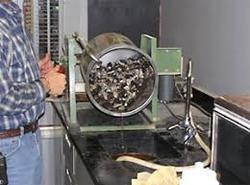
Building materials Testing
Providing you the best range of aggregate testing, cement testing, marble and granite testing, paint and coating testing, refractory testing and steel testing with effective & timely delivery.10% Fine Value
All aggregate is required to meet a minimum strength valve, as defined by the 10% value test. This and other specifications ensure that only the highest quality materials are being used on construction projects. Test Method IS 2386 (P-4)1963
Alkali Aggregate ReactivityAlkali-aggregate reaction is a term mainly referring to a reaction which occurs over time in concrete between the highly alkaline cement paste and non-crystalline silicon dioxide, which is found in many common aggregates. This reaction can cause expansion of the altered aggregate, leading to spalling and loss of strength of the concrete.
Test Method IS 2386 (P-7) 1963
The total chloride content of aggregate is usually measured to assess whether the aggregate^^s contribution to the total chloride content of a concrete mix will be low enough to prevent the early onset of corrosion of any embedded steel reinforcement.
Test Method IS 4032-1985
This test helps in determining the percentage of clay lumps and friable particles in aggregate. Clay lumps in aggregate shall be defined as any particles or aggregation of particles which when thoroughly wet can be distorted when squeezed between the thumb and forefinger, or will disintegrate into individual grain sizes when immersed for a short period in water. Friable particles are defined as particles which vary from the basic aggregate particles in that they may either readily disintegrate under normal handling and mixing pressures imposed upon them by construction procedures, or break down after being incorporated into the work.
Test Method IS 2386 (P-2) 1963
This test helps in determining the of a granular material. The size distribution is often of critical importance to the way the material performs in use. A sieve analysis can be performed on any type of non-organic or organic granular materials including sands, crushed rock, clays, granite, feldspars, coal and soil, a wide range of manufactured powders, grain and seeds, down to a minimum size depending on the exact method. Being such a simple technique of particle sizing, it is probably the most common.
Test Method IS 2386 (P-2) 1963
This test helps in determining the compaction percentage of an aggregate when loose compared to the same aggregate compacted in a standard manner. It is useful in assessing an aggregate^^s when placed loosely, for example, as a pipe surround material. Aggregate suitable for use as pipe bedding would display a low compaction fraction, indicating it reaches a state of near full compaction under loose placement.
Test Method
The Aggregate Crushing Value offers a related measure of the resistance of an average to crushing under a compressive load that is gradually applied.
Test Method IS 9376-1979, IS 2386 (P-4)1963
Drying shrinkage is defined as the contracting of a hardened concrete mixture due to the loss of capillary water. This shrinkage causes an increase in tensile stress, which may lead to cracking, internal warping, and external deflection, before the concrete is subjected to any kind of loading.
Test Method
Flakey is the term applied to aggregate or chippings that are flat and thin with respect to their length or width, Aggregate particles are said to be flakey when their thickness is less than 0.6 of their mean size. The flakiness index is found by expressing the weight of the flakey aggregate as a percentage of the aggregate tested.
Test Method IS 2386 (P-1) 1963